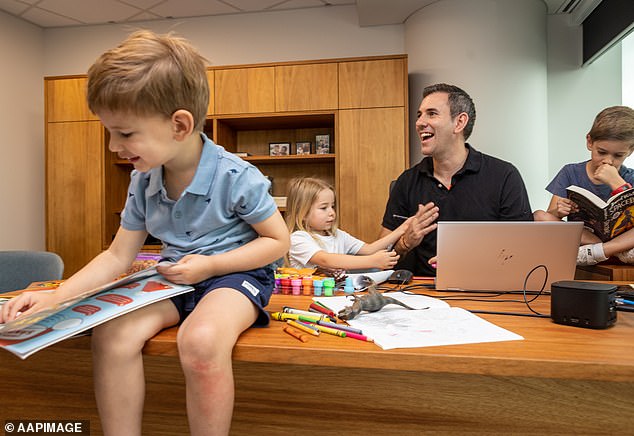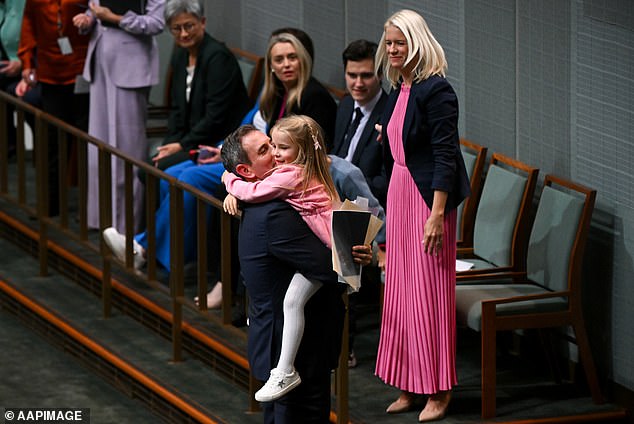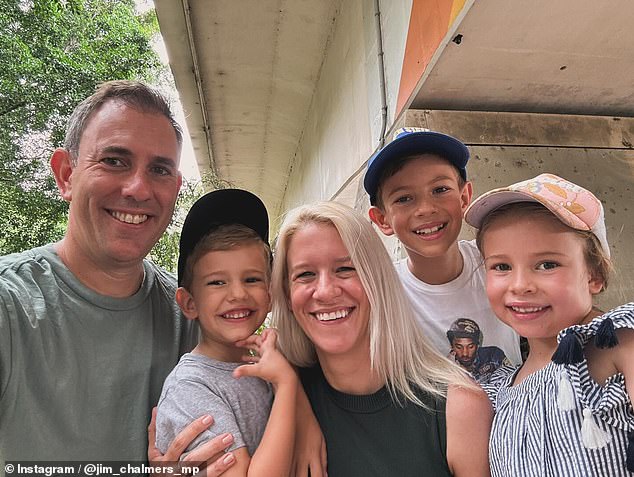Treasurer Jim Chalmers has said he wants Australian couples to have more children, even during a cost of living crisis.
With Australia having a low fertility rate, the father of three said larger families needed to be encouraged.
“We want to make it easier for people to have larger families if they want to and that’s why we’re making these huge investments in early childhood education,” he said Friday.
But Dr. Chalmers ruled out reviving the old baby bonus, which a decade ago awarded $5,000 to a new mother who had a child, or more than $8,000 in today’s money.
“We’ve found a better way to support people who make that decision,” he said.
“I know that some people can’t afford to have more children, I know that people will make their own decisions and I don’t for a moment claim that the government should direct those decisions.”
Treasurer Jim Chalmers has said he wants Australian couples to have more children even during a cost of living crisis (pictured, left, with wife Laura and three children Jack, Leo and Annabel).
Dr Chalmers has hinted that instead of the baby bonus, his third budget would seek to make paid parental leave more generous, highlighting the work of Finance Minister Katy Gallagher and Social Services Minister Amanda Rishworth.
“That’s why Katy and I worked so closely to make sure, with Amanda Rishworth, that we can expand paid parental leave and pay for the pension guarantee,” he said.
Former Liberal Treasurer Peter Costello introduced a $3,000 lump sum bonus for babies in July 2004, stating that parents should “have one for mum, one for dad and one for the country”.
But his Labor successor, Wayne Swan, scrapped the baby bonus in his last budget in May 2013, at which time it was $5,000.
Dr Chalmers at the time was chief of staff to Swan, who two months earlier had married Laura Anderson, Penny Wong’s former media ministerial adviser.
The Treasurer said Australia would benefit from “healthy birth rates” and the government’s goal was to make it easier for families to start if they wanted it too.
The old birth bonus had caused Australia’s fertility rate to rise from 1.73 in 2001 to 1.88 in 2011.
But by 2021, it had fallen back to 1.7, after hitting a record low of 1.59 during the 2020 pandemic.

Dr Chalmers ruled out reviving the old baby bonus, which a decade ago awarded $5,000 to a new mother who had a child, or more than $8,000 in today’s money (he appears in his Brisbane constituency office in 2022 with his children Jack , Annabel and Leo). )

Dr Chalmers has hinted that, instead of the baby bonus, his third budget would seek to make paid parental leave more generous, highlighting the work of Finance Minister Katy Gallagher and Social Services Minister Amanda Rishworth (the Treasurer appears in the May 2023 photo hugging her daughter Annabel). after delivering his second budget while his wife Laura watches)
The Treasury Intergenerational Report forecasts fertility will fall again to 1.62 by 2032/33, down from 1.66 in 2022/23.
This would make Australia even more reliant on immigration as the population ages, so the government would have to tax more people of working age.
Personal income taxes accounted for 45 per cent of the Commonwealth’s $618.2 billion in revenue during the last financial year.
Paid parental leave debuted in January 2011 and now the federal government pays for 20 weeks of leave, which will increase to 26 weeks starting in 2026.

